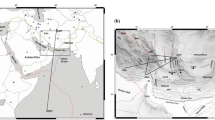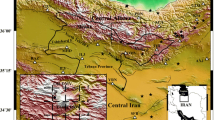Abstract
To investigate the relationship between velocity structure and earthquake activity on the southeastern front of the Tibetan Plateau, we make use of continuous observations of seismic ambient noise data obtained at 55 broadband stations from the regional Yunnan Seismic Network. These data are used to compute Rayleigh wave Green’s Functions by cross-correlating between two stations, extracting phase velocity dispersion curves, and finally inverting to image Rayleigh wave phase velocity with periods between 5 and 34 s by ambient noise tomography. The results show significant lateral variations in crustal and uppermost mantle structures in the studied region. Phase velocity anomalies at short periods (5–12 s) are closely related to regional tectonic features such as sediment thickness and the depth of the crystalline basement. The Sichuan-Yunnan rhombic block, enclosed by the Honghe, Xiaojiang and Jianchuan faults, emerges as a large range of low-velocity anomalies at periods of 16–26 s, that inverts to high-velocity anomalies at periods of 30–34 s. The phase velocity variation in the vicinity of the Sichuan-Yunnan rhombic block suggests that the low-velocity anomaly area in the middle-lower crust may correspond to lower crustal channelized flow of the Tibetan Plateau. The spatial distribution of strong earthquakes since 1970 reveals that the Yunnan region is inhomogeneous and shows prominent characteristics of block motion. However, earthquakes mostly occur in the upper crust, with the exception of the middle-Yunnan block where earthquakes occur at the interface zone between high and low velocity as well as in the low-velocity zones, with magnitudes being generally less than 7. There are few earthquakes of magnitude 5 at the depths of 15–30 km, where gather earthquakes of magnitude 7 or higher ones which mainly occur in the interface zone between high and low velocities with others extending to the high-velocity abnormal zone.
Similar content being viewed by others
References
Bai Z M, Wang C Y. 2003. Tomographic investigation of the upper crustal structure and seismotectonic environments in Yunnan Province. Acta Seismol Sin, 25: 117–127
Bensen G D, Ritzwoller M H, Barmin M P, et al. 2001. Proeessing seismic ambient noise data to obtain reliable broad-band surface wave dispersion measurements. Geophys J Int, 169: 1239–1260
Campillo M, Paul A. 2003. Long-range correlations in the diffuse seismic coda. Science, 299: 547–549
Chen W P, Molnar P. 1981. Constraints on the seismic wave velocity structure beneath the Tibetan Plateau and their tectonic implications. J Geophys Res, 86: 5937–5962
Chen Y, Zhang Z, Sun, C. 2012. Crustal anisotropy from Moho converted Ps wave splitting analysis and geodynamic implications beneath the eastern margin of Tibet and surrounding regions. Gondwana Res, 24: 946–957
England P, Houseman G. 1986.Finite strain calculations of continental deformation 2.Comparison with the India-Asia collision zone. J Geophys Res, 91: 3664–3676
Fang L H, Wu J P, Lü Z Y. 2009. Rayleigh wave group velocity tomography from ambient seismic noise in North China. Chin J Geophys, 52: 663–671
Flesch L M, Holt W E, Silver P G, et al. 2005. Constraining the extent of crust-mantle coupling in central Asia using GPS, geologic, and shear wave splitting data. Earth Planet Sci Lett, 238: 248–268
Gao Y, Liang W, Ding X, et al. 2004. Variational characteristics of shear-wave splitting on the 2001 shidian Earthquakes in Yunnan, China. Acta Seismol Sin, 26: 576–582
Guo S M, Xu J. 1991. The characteristics of seismic rupture (in Chinese). In: Ding G Y, ed. Lithospheric Dynamics of China (in Chinese). Beijing: Seismological Press. 237
He Z Q, Ye T L, Su W. 2004. S wave velocity structure of the middle and upper crust in the Yunnan region. Chin J Geophys, 47: 838–844
He Z, Ye T, Su W. 2005. 3-D velocity structure of the middle and upper crust in the Yunnan region, China. Pure Appl Geophys,162: 2355–2368
Hirn A, Jiang M, Sapin M, et al. 1995. Seismic anisotropy as an indicator of mantle flow beneath the Himalayas and Tibet. Nature, 375: 571–574
Hu H X, Gao S Y. 1993. The investigation of fine velocity structure of the basement layer of Earth’s crust in western Yunnan region. Earthq Res Chin, 9: 356–363
Hu J F, Su Y J, Zhu X G, et al. 2003. The structure and its meaning of shear wave speed and Poisson’s ratio at the crust of Yunnan. Sci China Earth Sci, 33: 714–722
Hu J F, Zhu X G, Xia J Y, et al. 2005. Using surface wave and receiver function to jointly inverse the crust-mantle velocity structure in the west Yunnan area. Chin J Geophys, 48: 1069–1076
Huang J L, Zhao D P, Zheng S H. 2001. Seismic tomography of the Sichuan-Yunnan active tectonic region. Chin J Geophys, 44(Suppl): 127–135
Li Y H, Wu Q J, Tian X B, et al. 2009.Crustal structure in the Yunnan region determined by modeling receiver functions. Chin J Geophys, 52: 67–80
Li Y, Yao H J, Liu Q Y. 2010. Phase velocity array tomography of Rayleigh waves in western Sichuan from ambient seismic noise. Chin J Geophys, 53: 842–852
Lin F C, Moschetti M P, Ritzwoller M H. 2008. Surface wave tomography of the western United States from ambient seismic noise: Rayleigh and Love wave phase velocity maps. Geophys J Int, 173: 281–298
Liu J H, Li Q. 1989. Three dimensional velocity images of the crust and upper mantle beneath north-south zone in China. Chin J Geophys, 32: 143–152
Lobkis O I, Weaver R L. 2001. On the emergence of the Green’s function in the correlations of a diffuse field. J Acoust Soc Am, 110: 3011–3017
McNamara D E, Owens T J, Silver P G, et al. 1994. Shear wave anisotropy beneath the Tibetan Plateau. J Geophys Res, 99: 13613–13655
Mei S R. 1995. The research on the mode of earthquake precursor field and the space-time distribution mechanism of precursor (1): Strong body seismogenicmodel. Acta Seismol Sin, 17: 273–282
Molnar P, Chen W P. 1978. Evidence of large Cainozoic crustal shortening of Asia. Nature, 273: 218–220
Nikolai M. Shapiro, Michel Campillo, et al. 2005. High resolution suface wave tomography from ambient seismic noise. Science, 307: 1615–1618
Royden L H, Burchfiel B C, King R W, et al. 1997. Surface deformation and lower crustal flow in eastern Tibet. Science, 276: 788–790
Shapiro N M, Campillo M, Stehly L, et al. 2005. High-resolution surface-wave tomography from ambient seismic noise. Science, 307: 1615–1618
Shapiro N M, Campillo M. 2004. Emergence of broadband Rayleigh waves from correlations of the ambient seismic noise. Geophys Res Lett, 31: 1–5
Shi Y, Gao Y, Su Y, et al. 2012. Shear-wave splitting beneath Yunnan area of Southwest China. Earthquake Sci, 25: 25–34
Su Y J, Liu Z Y. 1999. The deep Earth’s medium background of strong earthquake distribution in Yunnan region, Acta Seismol Sin, 21: 313–322
Tapponnier P, Meyer B, Avouac J P, et al. 1990. Active thrusting and folding in the Qilian Shan, and decoupling between upper crust and mantle in northeastern Tibet. Earth Planet Sci Lett, 97: 382–383
Tapponnier P, Peltzer G, Le Dain A Y, et al. 1982.Propagating extrusion tectonics in Asia: New insights from simple experiments with plasticine. Geology, 10: 611–616
Tarantola A, Valette B. 1982. Generalized nonlinear inverse problems solved using the least squares criterion. Rev Geophys Space Phys, 20: 219–232
Tian X B, Zhang Z J, 2013. Bulk crustal properties in NE Tibet and their implications for deformation model. Gondwana Res, 24: 548–559
Wang C Y, Chan W W, Mooney W D. 2003. Three-dimensional velocity structure of crust and upper mantle in southwestern China and its tectonic implications. J Geophys Res, 108: 176–193
Wang C Y, Huang F G. 2000. Deep seismic sounding of crustal structure in Tengchong volcanic area. J Seismol Res, 23: 148–156
Wang C Y, Wang X L, Su W, et al. 2006. Seismological evidence of the crust flowing under the eastern boundary part of Qinghai-Tibet Plateau. Earthq Res Sichuan, 4:1–4
Wang J H, Yin A, Harrison T M, et al. 2001. A tectonic model for Cenozoic igneous activities in the eastern Indo-Asian collision zone. Earth Planet Sci Lett, 188: 123–133
Wang Q, Gao Y. 2012. Present state and prospect of ambient noise tomography in the study of crust-mantle structure. Earthquake, 32: 70–81
Wang Y. 2001. Heat flow pattern and lateral variations of lithosphere strength in China mainland: Constraints on active deformation. Phys Earth Planet Inter, 126: 121–146
Wapenaar K, Thorbecke J, Draganov D. 2004. Relations between reflection and transmission responses of three-dimensional inhomogeneous media. Geophys J Int, 156: 179–194
Wei W, Sun R W, Shi Y L. 2010. P-wave tomographic images beneath southeastern Tibet: investigating the mechanism of the 2008 Wenchuan earthquake. Sci China Earth Sci, 40: 831–839
Wu J and Zhang Z J. 2012. Spatial distribution of seismic layer, crustal thickness, and Vp/Vs ratio in the Permian Emeishan Mantle Plume region. Gondwana Res, 22: 127–139
Xiang C Y, Zhou Z H. 2000. Relationship between seismicity and geothermal structure of the lithosphere in Yunnan Province, China. J Seismol Res, 16: 263–272
Xu G M, Yao H J, Zhu L B, et al. 2007. Shear wave velocity structure of the crust and upper mantle in western China and its adjacent area. Chin J Geophys, 50: 193–208
Xu Q, Zhao J M, Cui Z X, et al. 2009. Structure of the crust and upper mantle beneath the southeastern Tibetan Plateau by P and S receiver functions. Chin J Geophys, 52: 3001–3008
Yao H, Van Der Hilst R D, De Hoop M V. 2006. Surface-wave array tomography in SE Tibet from ambient seismic noise and two-station analysis-I. Phase velocity maps. Geophys J Int, 166: 732–744
Yao H, Van der Hilst R D, Montagner J P. 2010. Heterogeneity and anisotropy of the lithosphere of SE Tibet from surface wave array tomography. J Geophys Res, 115: B12307
Yao H, Xu G, Zhu L, et al. 2005. Mantle structure from inter-station Rayleigh wave dispersion and its tectonic implication in western China and neighboring regions. Phys Earth Planet Inter, 148: 39–54
Yin A, Harrison T M. 2000. Geologic evolution of the Himalayan-Tibetan orogen. Annu Rev Earth Planet Sci, 28: 211–280
Yuan X, Ni J, Kind R, et al. 1997. Lithospheric and upper mantle structure of southern Tibet from a seismological passive source experiment. J Geophys Res, 102: 27427–27491
Zeng R S, Song Z. Phase velocities of Rayleigh waves in China. Chin J Geophys, 12: 148–165
Zhang Z, Deng Y, Teng J, et al. 2011. An overview of the crustal structure of the Tibetan Plateau after 35 year of deep seismic soundings. J Asian Earth Sci, 40: 977–989
Zheng S, Sun X, Song X, et al. 2008. Surface wave tomography of China from ambient seismic noise correlation. Geochem Geophys Geosyst, 9: 1–8
Author information
Authors and Affiliations
Corresponding author
Rights and permissions
About this article
Cite this article
Wang, Q., Gao, Y. Rayleigh wave phase velocity tomography and strong earthquake activity on the southeastern front of the Tibetan Plateau. Sci. China Earth Sci. 57, 2532–2542 (2014). https://doi.org/10.1007/s11430-014-4908-2
Received:
Accepted:
Published:
Issue Date:
DOI: https://doi.org/10.1007/s11430-014-4908-2




